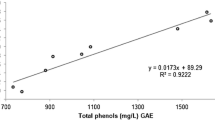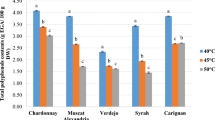Abstract
In this work, the anthocyanins’ profile of two hybrid grape varieties—Cabernet Carbon and Prior—grown in two experimental plots in Trentino (Northern Italy) was investigated during 2016 and 2017 harvests. The focus was on the mono- and di-glycoside anthocyanins extraction during the fermentative maceration. It was optimized an HPLC-DAD method, which allows the separation and quantification of mono- and di-glucoside anthocyanin forms (non-esterified, acetylated, and p-coumaroylated) in a single chromatographic run. Furthermore, an HPLC-DAD/HQOMS approach was used to confirm the compound identification. The skin contact fermentation was conducted for 7 days at 24 °C, punching down manually the cap twice a day. Must samples were collected every 24 h. As expected, every anthocyanin showed an initial net extraction phase described by a first-order kinetic, followed by a decrease until the end of the maceration. The analysis of the accumulation rate showed a faster increase of the di-glucoside anthocyanins concentration compared to the corresponding mono-glucoside, due to their richness in the initial grapes. Moreover, the di-glucosides concentration at the end of the alcoholic fermentation underwent a three times minor percentage decrease with respect to the maximum reached. This paper intend to improve the knowledge of the kinetics of each anthocyanin form during the maceration step, providing information about the behavior of di-glucoside compounds, never investigated before in terms of accumulation and percentage decrease.


Similar content being viewed by others
References
Fernández-López JA, Almela L, Muñoz JA, Hidalgo V, Carreño J (1998) Dependence between colour and individual anthocyanin content in ripening grapes. Food Res Int 31:667–672
He F, Mu L, Yan GL, Liang NN, Pan QH, Wang J, Reeves MJ, Duan CQ (2010) Biosynthesis of anthocyanins and their regulation in colored grapes. Molecules 15(12):9057–9091
Setford PC, Jeffery DW, Grbin PR, Muhlack RA (2017) Factors affecting extraction and evolution of phenolic compounds during red wine maceration and the role of process modelling. Trends Food Sci Technol 69:106–117
Van Buren JP, Bertino JJ, Einset J, Remaily GW, Robinson WB (1970) A comparative study of the anthocyanin pigment composition in wine derived from hybrid grapes. Am J Enol Viticult 21:117–130
Baldi A, Romani A, Mulinacci N, Vincieri FF, Casetta B (1995) HPLC/MS application to anthocyanins of Vitis vinifera L. J Agric Food Chem 43:2104–2109
Arozarena I, Ayestarán B, Cantalejo MJ, Navarro M, Vera M, Abril I, Casp A (2002) Anthocyanin composition of Tempranillo, Garnacha and Cabernet Sauvignon grapes from high- and low-quality vineyards over 2 years. Eur Food Res Technol 214:303–309
González-Neves G, Gil G, Barreiro L (2008) Influence of grape variety on the extraction of anthocyanins during the fermentation on skins. Eur Food Res Technol 226:1349–1355
Bautista-Ortín AB, Fernández-Fernández JI, López-Roca JM, Gómez-Plaza E (2004) Wine-making of high coloured wines: extended pomace contact and run-off of juice prior to fermentation. Food Sci Technol Int 10:287–295
Remy S, Fulcrand H, Labarbe B, Cheynier V, Moutounet M (2000) First confirmation in red wine of products resulting from direct anthocyanin–tannin reactions. J Sci Food Agric 80(6):745–751
Morata A, Gómez-Cordovés MC, Suberviola J, Bartolomé B, Colomo B, Suárez JA (2003) Adsorption of anthocyanins by yeast cell walls during the fermentation of red wines. J Agric Food Chem 51(14):4084–4088
Romero-Cascales I, Fernández-Fernández JI, López-Roca JM, Gómez-Plaza E (2005) The maceration process during winemaking extraction of anthocyanins from grape skins into wine. Eur Food Res Technol 221(1–2):163–167
Castia T, Franco MA, Mattivi F, Muggiolu G, Sferlazzo G, Versini G (1992) Characterization of grapes cultivated in Sardinia: chemometric methods applied to the anthocyanic fraction. Sci Aliments 12(2):239–255
Di Stefano R, Flamini R (2008) In: Flamini R (ed) Hyphenated techniques in grape and wine chemistry. Wiley, Chichester
Flamini R (2003) Mass spectrometry in grape and wine chemistry. Part I: polyphenols. Mass Spectrom Rev 22(4):218–250
Zhao Q, Duan CQ, Wang J (2010) Anthocyanins profile of grape berries of Vitis amurensis, its hybrids and their wines. Int J Molec Sci 11(5):2212–2228
Niu S, Hao F, Mo H, Jiang J, Wang H, Liu C, Fan X, Zhang Y (2017) Phenol profiles and antioxidant properties of white skinned grapes and their coloured genotypes during growth. Biotechnol Biotec Eq 31(1):58–67
Mazzuca P, Ferranti P, Picariello G, Chianese L, Addeo F (2005) Mass spectrometry in the study of anthocyanins and their derivatives: differentiation of Vitis vinifera and hybrid grapes by liquid chromatography/electrospray ionization mass spectrometry and tandem mass spectrometry. J Mass Spectrom 40(1):83–90
Oliveira J, Alhinho da Silva M, Teixeira N, De Freitas V, Salas E (2015) Screening of anthocyanins and anthocyanin-derived pigments in red wine grape pomace using LC-DAD/MS and MALDI-TOF techniques. J Agric Food Chem 63(35):7636–7644
Romero-Cascales I, Ortega-Regules A, López-Roca JM, Fernández-Fernández JI, Gómez-Plaza E (2005) Differences in anthocyanin extractability from grapes to wines according to variety. Am J Enol Viticult 56(3):212–219
Busse-Valverde N, Gomez-Plaza E, Lopez-Roca JM, Gil-Muñoz R, Bautista-Ortín AB (2011) The extraction of anthocyanins and proanthocyanidins from grapes to wine during fermentative maceration is affected by the enological technique. J Agric Food Chem 59:5450–5455
De Rosso M, Tonidandel L, Larcher R, Nicolini G, Ruggeri V, Dalla Vedova A, De Marchi F, Gardiman M, Flamini R (2012) Study of anthocyanic profiles of twenty-one hybrid grape varieties by liquid chromatography and precursor-ion mass spectrometry. Anal Chim Acta 732:120–129
Kontić JK, Jelušić IR, Tomaz I, Preiner D, Marković Z, Stupić D, Andabaka Z, Maletić E (2016) Polyphenolic composition of the berry skin of six fungus-resistant red grapevine varieties. Int J Food Prop 19(8):1809–1824
Liang Z, Wu B, Fan P, Yang C, Duan W, Zheng X, Chunyan L, Li S (2008) Anthocyanin composition and content in grape berry skin in Vitis germplasm. Food Chem 111(4):837–844
Liang Z, Owens CL, Zhong GY, Cheng L (2011) Polyphenolic profiles detected in the ripe berries of Vitis vinifera germplasm. Food Chem 129(3):940–950
De la Cruz AA, Hilbert G, Rivière C, Mengin V, Ollat N, Bordenave L, Decroocq S, Delaunay JC, Delrot S, Mérillon JM, Monti JP, Gomès E, Richard T (2012) Anthocyanin identification and composition of wild Vitis spp. accessions by using LC–MS and LC–NMR. Anal Chim Acta 732:145–152
Ribéreau-Gayon P, Glories Y, Maujean A, Dubourdieu D (2006) Handbook of enology volume 2: the chemistry of wine and stabilization and treatments. Wiley, Chichester
Segade SR, Vázquez ES, Losada ED (2008) Influence of ripeness grade on accumulation and extractability of grape skin anthocyanins in different cultivars. J Food Compos Anal 21(8):599–607
Tarara JM, Lee J, Spayd SE, Scagel CF (2008) Berry temperature and solar radiation alter acylation, proportion, and concentration of anthocyanin in Merlot grapes. Am J Enol Viticult 59(3):235–247
Lago-Vanzela ES, Procópio DP, Fontes EAF, Ramos AM, Stringheta PC, Da-Silva R, Castillo-Muñoz N, Hermosín-Gutiérrez I (2014) Aging of red wines made from hybrid grape cv. BRS Violeta: effects of accelerated aging conditions on phenolic composition, color and antioxidant activity. Food Res Int 56:182–189
Acknowledgements
The research was partially granted by the Provincia Autonoma di Trento through the PROGETTO VEVIR (RDP 2014-2020).
Author information
Authors and Affiliations
Corresponding author
Ethics declarations
Conflict of interest
The authors report no conflict of interest.
Compliance with ethic requirements
This article does not contain any studies with human or animal subjects.
Additional information
Publisher's Note
Springer Nature remains neutral with regard to jurisdictional claims in published maps and institutional affiliations.
Rights and permissions
About this article
Cite this article
Roman, T., Barp, L., Malacarne, M. et al. Mono- and di-glucoside anthocyanins extraction during the skin contact fermentation in hybrid grape varieties. Eur Food Res Technol 245, 2373–2383 (2019). https://doi.org/10.1007/s00217-019-03355-4
Received:
Revised:
Accepted:
Published:
Issue Date:
DOI: https://doi.org/10.1007/s00217-019-03355-4




